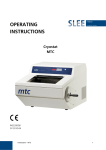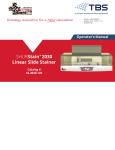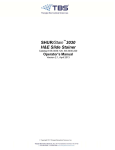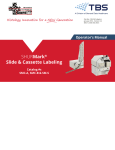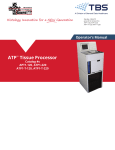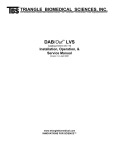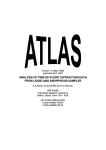Download 2563 Service Manual.pmd - Triangle Biomedical Sciences
Transcript
TRIANGLE BIOMEDICAL SCIENCES, INC. 3014 Croasdaile Drive, Durham, NC 27705 USA Ph: (919)384-9393 Fax: (919)384-9595 E-Mail: [email protected] Minotome Plus TM OPERATION MANUAL OM2563 Version 1.1 TRIA NGL E BIO MED ICA L SC IEN CES , INC . Microtome Cryostat Cat # 2563 - 115V, 60Hz; 100V, 50Hz Cat # 2564 - 240V, 50Hz; 200V, 50Hz Minotome Plus Operation Manual 1-21-98 1 Table of Contents 2 1.0 SIMPLIFIED OPERATING INSTRUCTIONS..................................... 3 2.0 INSTALLATION.............................................................................. 2.1 Microtome Adjustment...................................................... Microtome Alignment ....................................................... 2.2 Disposable Blade Holder Installation................................. 2.3 Positioning of Knife Holder Assembly............................... 2.4 Specimen Holder Angle Adjustment.................................. 2.5 Optional Knife................................................................... 2.6 Anti-Roll Plate Alignment................................................... 2.7 Optional Index Post........................................................... 5 6 6 7 7 7 8 8 10 3.0 OPERATION.................................................................................. 3.1 Warnings and Cautions.................................................... 3.2 Control Panel.................................................................... 3.3 Sectioning......................................................................... First Use........................................................................... Temperature Selection...................................................... Thickness Selection.......................................................... Sample Preparation........................................................... Cutting.............................................................................. 3.4 Troubleshooting................................................................ 11 11 12 14 14 14 14 14 15 16 4.0 MAINTENANCE.............................................................................. 4.1 Cleaning............................................................................ 4.2 Decontamination............................................................... 4.3 Spare Parts....................................................................... 4.4 Lubrication........................................................................ 4.5 Warranty........................................................................... 4.6 Condition of Returned Equipment..................................... 17 17 18 19 19 21 21 5.0 SPECIFICATIONS.......................................................................... 22 5.1 23 Temperature Selection Table............................................. Minotome Plus Operation Manual 1.0 SIMPLIFIED OPERATING INSTRUCTIONS General The TBS Minotome Plus™ is designed for use as a cryogenic sectioning device in clinical, pathological and research applications. Do not attempt to use the instrument unless you are professionally trained in the use of similar devices. Installation Roll the cryostat to the desired location and lock the front casters. Allow a minimum of 4 inches clearance on all sides of the cryostat for proper ventilation. Allow additional clearance on the right side for easy rotation of the handwheel. The international model (Cat. NO. 2564) is shipped for use at 240 VAC. To use it on a different voltage source the autotransformer must be reconfigured. A qualified electrical technician should use an AC Voltmeter to measure the voltage at the installation site. After removing the rear panel, relocate the BROWN wire to the autotransformer tap which is closest to the measured line voltage. Replace the rear panel. To minimize line load variations, the Minotome Plus™ should be connected to a dedicated line. The line voltage supply must be a standard three-wire, grounded, single-phase circuit. Operation Select an appropriate chamber temperature. Insert a disposable blade (H-DMB-HD) into the Shur/Sharp™ disposable blade holder (already installed in the cryostat). Loosen the thickness lock at the top of the index post and rotate the index so a setting lines up with the etched guide. Settings of 1 through 8 may be selected, where 1 corresponds to 2 microns and 8 corresponds to 16 microns. Place the specimen holder into the ball and chuck assembly so the notch on the outer edge of the specimen holder lines up with the knurled screw. Turn the knurled screw until it is finger tight. Advance the sample until it is approximately 1/8 inch from the cutting edge using one of the following methods: 1. Motorized: 2. Manual: 3. Knife Holder: Press the ADVANCE/RETRACT switch downward and hold. Turn the large ratchet wheel at the rear of the microtome clockwise, being careful of the blade. Loosen the knife holder assembly locking lever by moving it to the right and slide the assembly forward. Return the locking lever to the original locking position. Rotate the anti-roll plate away from the disposable blade. Ensure that the ratchet pawl on the large ratchet wheel at the rear of the microtome is in the 'engaged' position (toward the right). Rotate the handwheel several times until the blade contacts the sample. Make several initial cuts until the desired sectioning face is obtained. Rotate the anti-roll plate back into position to begin sectioning. Minotome Plus Operation Manual 3 Warnings & Cautions Below are listed important operating procedures. Be certain to follow the instructions carefully. Warranty/ Service 4 • Do not locate the Minotome Plus™ in direct sunlight or near any airhandling ducts. • The microtome should always be lubricated after cleaning and/or monthly . Do so at operating temperature. Lubricate with TBS's Shur/Lube™ (H-LUB) . • When sectioning for extended periods of time, the chamber temperature may rise. Close the window and allow the cryostat time to recover. • There is no automatic stop to prevent the main feed screw from advancing too far (completely out). Retract the assembly regularly to avoid damage to the microtome. • Always put the ratchet lever in the 'manual' position before retracting, in order to avoid damaging the microtome motor. • Before decontaminating the microtome, be sure to remove the motor assembly from the rear of microtome. • The Shur/Sharp™ disposable microtome blades are very sharp. To prevent injury, use extreme caution when handling. • Carefully remove and properly discard spent blades. • If infectious or radioactive material have been sectioned, immediately sterilize or decontaminate the Minotome Plus™ and its components. • The power cord must be plugged into a grounded power outlet. Never remove the grounding prong from the power plug or use any adapter which defeats, or does not complete, the power ground circuit. • The quick freeze plate is extremely cold and is active whenever the compressor is running. Prolonged contact with unprotected skin may result in burns. TBS warrants for a period of one year (12 months) from the date of shipping, under normal and proper usage, all of its products against defects in workmanship and material, and will repair or replace the same without charge when shipped prepaid to TBS' factory in Durham, NC. User is required to return the warranty card to TBS within ten (10) days after receipt of the product in order to validate the warranty. Warranty service for international shipments is handled by the selling agent. For further information, please call (919)384-9393. Minotome Plus Operation Manual 2.0 INSTALLATION Follow the instructions on the outside of the shipping carton to unpack the cryostat. The Minotome Plus™ is shipped with the microtome installed in the cryostat chamber and the Shur/ Sharp™ Blade Holder and anti-roll device in position. Roll the cryostat to the desired location and lock the front casters by pushing the small locking lever on the top of each wheel with your foot. Allow a minimum of four inches clearance on all sides of the cryostat for proper ventilation. Allow additional clearance on the right side for easy rotation of the handwheel. The international model (Cat. No. 2564) is shipped for use at 240 VAC. To use it on a different voltage source the autotransformer must be reconfigured. Only a qualified electrical technician should make the following adjustments: Using an AC Voltmeter, measure the voltage at your site. Remove the rear panel. Relocate the BROWN wire to the autotransformer tap which is closest to the measured line voltage. Replace the rear panel. To minimize line load variations, the Minotome Plus™ should be connected to a dedicated line. The line voltage supply must be a standard three-wire, grounded, single-phase circuit. Warning: The power cord must be plugged into a grounded power outlet. Never remove the grounding prong from the power plug or use any adapter which defeats, or does not complete, the power ground circuit. The power cord provided with the Minotome Plus™ is correctly rated for the highest current demand. This power cord should never be interchanged with cords from equipment with lower current demand. Incorrect power cords can create a fire hazard. Plug the cryostat in and review the Control Panel settings (section 3.2). If you encounter difficulty sectioning, follow the more detailed Microtome Adjustment instructions (section 2.1). Minotome Plus Operation Manual 5 2.1 Microtome Adjustment The microtome is installed in the cryostat at the factory, but may require some adjustment on-site for proper sectioning. The following adjustments may be made to correct a common problem of 'thick and thin' or inconsistent sectioning. Warning: Disposable microtome blades and reusable knives are extremely sharp. To prevent injury, use extreme caution when handling. Microtome Alignment Although the microtome is installed at the factory, its alignment may shift during transport. Misalignment results in a 'clunking' sound when the handwheel is turned. To realign, loosen the two large black thumbscrews which secure the microtome to the cryostat. Loosen the two set screws that couple the outer handwheel shaft to the inner microtome shaft. Pull the handwheel away from the cryostat. Check that the handwheel is securely fastened to the outer shaft, by holding each and turning to feel for any 'play' between them. The handwheel is secured by two set screws which must be aligned with flat surfaces on the outer shaft. If any looseness is found, align and tighten the set screws. Slide the handwheel back toward the cryostat, taking care to align the set screws in the outer handwheel shaft with the flat surfaces of the inner microtome shaft, and tighten. Rotate the handwheel and reposition the microtome until no 'clunking' sound is heard. Then, while rotating the handwheel slowly, alternately tighten down the large black thumb screws in small increments. Rotate the handwheel. Feel for any binding. If the turning action is difficult, the outer shaft may need to be freed up by loosening the wedge (outside of cabinet) or seal (inside cabinet). Once either is loosened, rotate the handwheel to free up the shaft and secure the wedge or seal back in place (both should be centered about the shaft). Set Screws Seal Inner Shaft Handwheel Set Screws Outer Shaft Wedge Handle Handwheel Lock Coupling 6 Minotome Plus Operation Manual 2.2 Disposable Blade Holder Installation A Shur/Sharp™ Disposable Blade Holder and blades are standard items supplied with the Minotome Plus™ . The anti-roll plate is configured for use with the disposable blade system. To reconfigure the anti-roll mechanism for use with reusable knives, see section 2.6. Specimen Holder Warning: Disposable blades and reusable knives are extremely sharp. To prevent injury, use extreme caution when handling. Disposable Blade Holder or Knife Back the two knife holder screws out until they are no longer visible from the front of the unit. Advance one knife holder screw until one thread is visible. (Some units may require up to two threads to be visible.) Secure screw in place by tightening the lock nut around it. Repeat procedure for remaining screw. Tighten both knife clamps down. Knife Clamp Knife Holder Screw Lock Nut Holder Bracket 2.3 Knife Holder Assembly Adjustment When the "Knife Holder Assembly" locking lever (at front and bottom of knife holder assembly) is tightened down (slid left), the entire assembly should be immobile (no sideways motion, unable to slide forward or backward). If it is mobile, remove the assembly from the microtome base and slide the locking lever to the right. Using a flathead screwdriver, rotate the center bolt counter-clockwise (not too tight). Be sure that the locking lever can still be tightened by sliding it left. Locate the set screw beneath the front of the assembly, and ensure that it is tight. Replace the assembly in the microtome base. 2.4 Specimen Holder Angle Adjustment Locking Lever Install the specimen orientation ball assembly and detachable specimen holder as shown. Lightly tighten the specimen orientation handle so that the ball assembly is still moveable. Be certain the knurled screw is tight. Position the loose specimen orientation ball assembly so that the detachable specimen holder is completely vertical with respect to the blade edge facet. (Place a flat ruler vertically on top of the knife holder screws and slide the knife holder forward to engage the loose assembly.) Tighten the specimen orientation handle to set the angle. Minotome Plus Operation Manual 7 2.5 Optional Knife The resharpenable knife (Cat# 3257) is an option and can be used as an alternative to the Disposable Blade System. A modification of the anti-roll plate is required (see section 2.6). The installation and cutting angle adjustment procedures are similar for reusable knives and the Shur/Sharp™ disposable blade system although the knife holder screws may require more threads showing in order to compensate for the different cutting angles of reusable knives. 2.6 Anti-Roll Plate Alignment Proper adjustment of the anti-roll plate may be made once the upper edge of the plate is aligned parallel to the edge of the disposable blade or reusable knife. To accomplish this, loosen the two slotted screws on the right side mounting support. The assembly can then be shifted until the edges are parallel. Tighten the two slotted screws once the plate is aligned. The height of the anti-roll plate relative to the blade is also important. If the plate is too high, the sample will hit the plate instead of the blade. If the plate is too low, the sample will curl up in front of the plate. The height is adjusted by first loosening the small thumbscrew lock. Next, turn the adjustment screw by its rubber cap to raise or lower the plate. Once the samples feed smoothly between the plate and blade, tighten the thumbscrew lock.ppppppppppppppppppppppppppppp Note: A dirty or damaged (nicked upper edge) anti-roll Slotted Screws plate will cause the sample to tear or bind. Additional Round-head Screw anti-roll plates (Cat#3267A) can be ordered. (Acorn Nut) All anti-roll plates are shipped from the factory configured for the Disposable Blade Holder. To reconfigure the anti-roll plate assembly for reusable knives: 1. Loosen (do not remove) the round-head screw (acorn nut) on the right side of the anti-roll plate mounting support. 2. Remove the anti-roll plate assembly. Be careful to restrain the spring while disassembling. Wear protective glasses. Take it to a bench and rework it as follows: - Use needle-nose pliers or forceps to remove the E-ring. - Remove anti-roll plate, plastic washer and spring. - Reassemble the anti-roll plate parts in the following order: first put anti-roll plate; followed by the spring, next the plastic washer, and finally put the E-ring back into its original slot to hold the parts together. 3. Put the reworked anti-roll plate assembly back into its mounting supports so that the thumbscrew lock now faces up. This is very important because the anti-roll plate is now inverted from its original position. Turn the round-head screw just enough to hold the anti-roll plate in place, but do not tighten them against the side of the anti-roll plate support yet. 8 Minotome Plus Operation Manual Install the reusable knife as follows: 1. Loosen both knurled knife-clamp finger screws. 2. WARNING: The top edge of the knife is very sharp. Very carefully remove the knife. Place it so that it is centered between the microtome knifeclamp fingers. 3. Tighten both knurled knife-clamp finger screws. 4. Use the anti-roll adjust and lock knobs to align and lock the anti-roll plate just above the knife edge to prevent specimen curling. The anti-roll plate should be parallel to the knife edge. If it is, tighten both slotted screws on the right side of the anti-roll plate mounting support. If not, adjust it as follows: - Loosen, but do not remove, both slotted screws on the right side of the anti-roll plate mounting support. - Adjust the anti-roll plate so that it will be parallel to the knife edge. - Tighten both slotted screws. NOTE: If sections curl up in front of the anti-roll plate, then the plate must be adjusted forward. If a specimen hits the plate, then the plate is too far forward and must be adjusted backward. NOTE: The knife angle may need readjustment. At this point, you are ready to start sectioning. IMPORTANT: Do not store or leave a blade in place for extended periods. Leave the blade holder clamp in the open position when not in use. Minotome Plus Operation Manual 9 2.7 Optional Index Post Optional index post Cat. No. 3347 allows the user to section 18 to 32 µm or 34 to 42 µm. To install, locate and loosen the set screw at the rear of the microtome base which secures the index post position. Remove the original post, and install the optional post with the flat portion toward the rear and the red lines facing the user. Adjust the height of the post so one red line is flush with the top surface of the base. Use lower red line for 18 to 32 µm and the upper red line for 34 to 42 µm. Rotate the handwheel and listen to ensure that the correct number of 'clicks' can be heard for each setting (see table). Standard Index Post - 2 to 16 µm Setting 1 2 3 4 5 6 7 8 No. of Clicks 1 2 3 4 5 6 7 8 Microns Advanced 2 4 6 8 10 12 14 16 Optional Index Post - 18 to 32 µm (lower red line) Setting 1 2 3 4 5 6 7 8 No. of Clicks Microns Advanced 9 10 11 12 13 14 15 16 18 20 22 24 26 28 30 32 Index Post - 34 to 42 µm (upper red line) Setting 1 2 3 4 5 No. of Clicks 17 18 19 20 21 Microns Advanced 34 36 38 40 42* *Maximum setting. (See Caution) *Caution: Do not set the microtome to advance more than 42 µm. A greater setting will not allow the specimen to clear the blade before advancing. 10 Minotome Plus Operation Manual 3.0 OPERATION 3.1 Warnings and Cautions • Disposable blades and reuseable knives are very sharp. To prevent injury, use extreme caution when handling. • If infectious or radioactive material has been sectioned, IMMEDIATELY sterilize or decontaminate the Minotome Plus™ and its components. • To avoid electrical shock, the power cord must be plugged into a grounded power outlet. Never remove the grounding prong from the power plug or use any adapter which defeats, or does not complete, the power ground circuit. • The quick freeze plate is extremely cold, and is active whenever the compressor is running. Prolonged contact with unprotected skin may result in burns. • Do not position the Minotome Plus™ in direct sunlight, or near any airhandling ducts. Allow four inches of space on all sides of the Minotome Plus™ for proper ventilation. • The microtome requires periodic lubrication, based on usage. It should always be lubricated after cleaning. The procedure should be done once it has reached operating temperature. • Lubricate the microtome with Shur/Lube™ (H-LUB), a specialty chemical formulation designed to lubricate the various metals utilized under sub-zero operating conditions. • When sectioning for extended periods of time, the chamber temperature may rise. Close the window and allow the cryostat time to recover if the sections become mushy. • There is no automatic stop to prevent the main feed screw from advancing too far (completely out). Retract the assembly regularly to avoid damage to the microtome. • The ratchet lever must be in the 'manual' (toward the left) position to allow the specimen holder assembly to retract. The motor will not be able to retract otherwise, and will emit a loud noise. Always put the ratchet lever in the 'manual' position before retracting to avoid damaging the microtome motor. Return the ratchet lever to the right "engaged" for continued cutting. • Before decontaminating the microtome, be sure to remove the motor assembly. It may not be compatible with some processes of decontamination. See Section 4.2 Decontamination. Minotome Plus Operation Manual 11 3.2 Control Panel The front control panel of the Minotome Plus™ is used to set chamber parameters and activate the chamber controls. CHAMBER LIGHT QUICK FREEZE Press the QUICK FREEZE button to deliver refrigerant to the quick freeze bar on the left side of the chamber for 10 minutes to provide rapid sample preparation. When pressed again, this function is terminated. The quick freeze is activated when the light in the button is illuminated. (Note: During normal cooling the refrigerant is cycled through the quick freeze plate. This function activates refrigeration when it has cycled off or extends it for a period of 10 minutes. Once stopped, there is an intentional three minute delay before the compressor can be re-started. ) MANUAL DEFROST Press the MANUAL DEFROST button to activate a 3 minute (approx.) defrost cycle. A defrost cycle may be terminated by pressing the button again. Periodic manual defrost, in addition to the automatic defrost, is recommended if climate conditions are hot and/or humid. Following a defrost, some ice will remain in the drip tray below the evaporator at the rear of the chamber. When the light in this button is illuminated, a defrost is in progress. FREEZE PLATE TEMP. Press the FREEZE PLATE TEMP button to view the quick freeze plate temperature. An illuminated light in this button indicates the quick freeze plate temperature is displayed. CHAMBER TEMP. 12 Press the CHAMBER LIGHT button to illuminate or shut off the fluorescent lamp inside the cutting chamber. The chamber light is "on" when the light in the button is illuminated Press the CHAMBER TEMP button to view and change the desired chamber temperature. If the display is indicating the freeze plate temperature then pressing the CHAMBER TEMP button returns the display to the actual chamber temperature. Pressing the CHAMBER TEMP button again will cause the display to flash, indicating it is in the change mode. Use the up and down arrow keys to change the display to the desired temperature. When the desired temperature is reached, simply press the CHAMBER TEMP button again and the display will revert to the actual chamber temperature. An illuminated light in this button indicates the actual chamber temperature is being displayed. Minotome Plus Operation Manual The arrow buttons are used along with the time and temperature control buttons for setting the desired parameters. DEFROST SET The DEFROST SET button is used to select the desired automatic defrost time. This time is set for 1:00 AM from the factory. If a different time is desired, press the DEFROST SET button once and use the up and down arrow keys to change the hour display to the desired time. Press the DEFROST SET button again and use the arrow keys to change the minute display. When the desired defrost time is reached, simply press the DEFROST SET button and the display will revert to the current time. The automatic defrost time is in the change mode when the light in the button is illuminated CLOCK SET The CLOCK SET button is used to change the displayed time. The time is set for Eastern Standard Time from the factory. If a different time is required, press the CLOCK SET button and use the up and down arrow keys to change the hour display. Press the CLOCK SET button again and use the arrow keys to change the minute display. When the current time is reached, simply press the CLOCK SET button and the display will indicate the current time. An illuminated light in this button indicates the current time displayed is in the change mode. The RETRACT/ADVANCE switch is used to advance or retract the specimen holder assembly. The specimen holder assembly can be advanced at any time. To ensure rigidity when sectioning, the specimen holder assembly should never be extended more than 1/2 inch. Caution: There is no automatic stop to prevent the main feed screw from advancing too far (completely out). Retract the assembly regularly to avoid damage to the microtome. To coarse advance, press and hold the toggle switch downward. To advance approximately 20 µm only, depress the toggle switch once, and release. Minotome Plus Operation Manual 13 The specimen holder assembly can only be retracted if the ratchet pawl is in the 'manual' position. Caution: The ratchet pawl must be in the 'manual' position to allow the specimen holder assembly to retract. The motor will not be able to retract otherwise, and will emit a loud noise. Always place the ratchet pawl in the 'manual' position before retracting to avoid damaging the microtome motor. Once the ratchet pawl is in the 'manual' position, press and hold the toggle switch upward to retract the specimen holder assembly. Once it is fully retracted, the motor will emit a loud noise indicating it cannot retract any further. 3.3 Sectioning First Use TM When the Minotome Plus has been plugged in, and a chamber temperature has been selected, it takes approximately one hour to achieve an air temperature of -20°C. It will take several hours for all the metal mass of the microtome and blade holder to reach equilibrium. For best results, do not rush the process. Once set temperature is reached, the microtome may require adjustment (see Section 2.1 Microtome Adjustment) and lubrication (see Section 4.4 Lubrication). Temperature Selection Select an appropriate chamber temperature according to the chart at the rear of this manual. If the sample fragments or splits when sectioning, the selected temperature may be too cold. If the selected temperature is too warm, the sample will seem soft and sections will collect at the blade edge. Thickness Selection The index post is used to set the desired section thickness. Loosen the thickness lock at the top of the index post and rotate the index adjust so a setting lines up with the etched guide. Settings of 1 through 8 may be selected. Refer to the tables in Section 2.7 to identify thickness by setting number. Sample Preparation The holes in the quick freeze plate on the left side of the chamber can accommodate up to 13 specimen holders for sample preparation. When the refrigeration system is on, the quick freeze plate temperature is approximately -40°C. If it is not on, press the QUICK FREEZE button on the control panel and the system will cycle on (a three minute delay between cycles may slow the start). Place a small amount of embedding medium (TFM ) on a specimen holder. When it starts to turn white and solidify, place the specimen on the plate and surround it with more embedding medium. Allow it to freeze thoroughly before sectioning. The heat extractor (Cat#2085) can be used to accelerate the process. TM Sample Position 14 The specimen holder angle should be vertical (see Section 2.1 Microtome Adjustment) before sectioning. Place the specimen holder into the ball and chuck assembly so the notch on the outer edge of the specimen holder lines up with the knurled screw. (When knurled screw is tightened it should engage a small hole. This prevents looseness in the section mounting.) Tighten the knurled screw finger tight. Minotome Plus Operation Manual The sample can be brought closer to the blade edge by one of the following methods: Motorized: Press the ADVANCE/RETRACT switch downward and hold. Manual: Turn the large ratchet wheel at the rear of the microtome clockwise, being careful of the blade. Knife Holder: Loosen the knife holder locking lever by moving it to the right, and slide the knife holder assembly forward. Use any method to advance until the Disposable Blade Edge is approximately 1/8 inch from the sample. Rotate the anti-roll plate away from the blade. Cutting Ensure that the ratchet pawl is in the 'automatic' position (toward the right). Rotate the handwheel several times until the blade engages the sample. Note: To advance more quickly using the handwheel, rotate the handwheel from 12 o'clock to 3 o'clock and then back to 12. Each of these forward movements advances the sample without making a pass by the blade. Make several 'rough' cuts until the desired sectioning face is obtained. Rotate the anti-roll plate back into position to begin sectioning. At this point, each turn of the handwheel will produce one section. Minotome Plus Operation Manual 15 3.4 Troubleshooting Problem Possible Cause Corrective Action No Lights Blown fuse on circuit board Call for service No Cooling Refrigerant problem Call for service Chamber temp. rising Sectioning too long Evaporator Blocked Close window Defrost No motor action Loose wiring Check motor connector Microtome not advancing Ratchet pawl in 'manual' position (no clicks heard) Weak pawl spring Frost on ratchet wheel Move to 'automatic' Replace spring Clean ratchet wheel Inconsistant sections (Thick and Thin) Loose blade holder Loose specimen Dull Blade Improper Blade Holder angle Loose Microtome Tighten locking lever Tighten specimen holder screw Replace/resharpen Adjust angle (see Sec. 2.2) Tighten thumbscrews/set screws Sections fragment Too cold Knicked or damaged Anti-roll plate Raise chamber temperature Replace anti-roll plate Sections gather (at knife edge) Too warm Anti-roll plate incorrectly positioned Knicked or damaged Anti-roll plate Dull Blade Lower chamber temperature Adjust height (see Sec. 2.6) Replace anti-roll plate Replace/resharpen Handwheel hard to turn Dry Microtome Shafts misaligned Wedge or seal binding Lubricate Align (see Sec. 2.1) Adjust (see Sec. 2.1) 16 Minotome Plus Operation Manual 4.0 4.1 MAINTENANCE Cleaning The Minotome Plus ™ should be unplugged and allowed to warm up to room temperature before cleaning. Remove the disposable blade system and any blades stored in the chamber. To prevent rusting, run them under warm water until they are room temperature and dry thoroughly. Remove rubber drain plug from bottom of inner chamber. Warning: The microtome disposable blades are very sharp. To prevent injury, use extreme caution when handling. Clean the outside of the Minotome Plus™ and the inside of the chamber with a damp sponge using a mild detergent (non-abrasive). The microtome must be removed for cleaning. Loosen the two set screws that couple the outer and inner shafts and pull the handwheel out. Loosen and remove the large black thumbscrews which secure the microtome to the chamber. Disconnect the motor wiring. Carefully lift the microtome out of the chamber. (Note: The microtome weighs approximately 45 pounds.) Before cleaning the microtome, remove the motor by loosening the set screw that holds it in place. The microtome can be cleaned with absolute alcohol. If any water based solutions are used, the microtome must be dried thoroughly using alcohol or a source of warm dry air. Note: The microtome must be lubricated after cleaning. Install the motor, taking care to line up the flat side of the shaft with the set screw. Place the microtome into the crystat chamber and install according to the instructions in Section 2.1 Microtome Adjustment. Re-connect the motor wiring. Replace rubber drain plug. Periodically, the air flow path for the refrigeration system should be checked for any restrictions (dust, dirt). Remove the access panel on the left side of the cryostat and clean out the condenser. Also, ensure that the vents on the right side are free of dust or dirt. Minotome Plus Operation Manual 17 4.2 Decontamination If infectious tissue has been sectioned, IMMEDIATELY decontaminate the work area and the inside of the microtome cryostat chamber as cited by Billy L. Swisher and Edwin P. Ewing Jr. in the article entitled, Frozen Sectioning Techniques for Tissues Infected by the Aids Virus in the Journal of Histotechnology, Vol. 9, No. 1, March, 1986, page 29: Specimen Handling Infections by the AIDS virus are known to occur only by direct contamination of the blood (1) or mucosal surfaces (2). Therefore, safety measures are directed toward prevention of cuts, and protection of the eyes, nose and mouth. Protective Clothing 1. Double gloves 2. Eyeglasses or goggles 3. Mask 4. Gown Technique 1. Confine possible benchtop contamination to small area. 2. Drop mounting medium onto specimen holder plate and at the appropriate time add tissue. DO NOT allow dispenser to touch tissue. 3. DO NOT create any aerosol in the chamber. 4. Briefly immerse entire frozen section slide in 10% formalin. 5. Remove double gloves, withdraw slide from formalin with clean forceps and proceed with staining procedure. 6. When technical procedure is completed, put on clean gloves and place residual tissue in 10% formalin to fix thoroughly before it is handled again. Decontamination of Cryostat The AIDS virus is known to be inactivated by 0.5% sodium hypochlorite (1:10 dilution of household bleach) (3,4), 95% ethanol (3, 4, 5, 6) and 10% formalin (6). Sodium hypochlorite is the most effective decontaminant known for the virus but it will also corrode metal. Therefore, 95% ethanol is favored for the inside of the cryostat. The AIDS virus does survive both freezing and drying (4, 6), so decontamination is essential. 1. Turn off refrigeration. Allow chamber to warm to room temperature. 2. With protective clothing in place, remove the blade from microtome and place it in a pan of 95% ethanol on the floor of the cryostat chamber where water will collect. 3. If complete defrosting is desired, pour a small amount of 95% ethanol on the floor of the cryostat chamber where water will collect. 4. Wipe all exposed surfaces inside and outside the cryostat chamber with a towel or sponge that has been soaked in 95% ethanol. 5. Replace the disposable blade holder or knife from freezer. 6. Turn on refrigeration for return to desired temperature. Another decontamination technique, recommended before the ethanol sensitivity of the AIDS virus was known, consists of placing a large beaker of 40% formalin in the closed and defrosting chamber overnight. However, the moveable parts must be lubricated before the cryostat is used again. 18 Minotome Plus Operation Manual Cleanup of Work Area Personnel not directly involved with preparing frozen section and decontaminating the cryostat must also be protected from exposure to the AIDS virus. 1. Do not touch other objects in room while wearing contaminated gloves. 2. Place instrument in 0.5% sodium hypochlorite for 15 minutes, wash well in tap water and autoclave. 3. Wipe bench top with 0.5% sodium hypochlorite. 4. Place all contaminated towels, protective clothing, etc. in double plastic bags. Use separate containers for disposable and reusable items. Bags MUST NOT contain sharp objects. 5. Contaminated garments should never be worn outside the frozen section room. 6. Attach biohazard labels to bags. 7. Wash hands before leaving the area. 4.3 Spare Parts Part. No. 3347 3434 H-DMB-HD H-DMBH H-LUB 3331 3408 H-TFM H-FRZ-1 3267 3267A H-ARD 3330 3375 2085 H-BR 4.4 Description Index Post (18 to 42 microns) Disposable Blade Holder Disposable Blades (heavy duty) Disposable Blade Holder Shur/Lube Microtome Lubricating Oil Specimen Holder (Concentric Circles) Specimen Holder (Cross Hatch) Tissue Freezing Medium Shur/Freeze Cryogen Spray Anti-roll Plate with Feed Screw Anti-roll Plate without Feed Screw Anti-roll Device Ball Chuck for specimen holders #3331 and #3408 Replacement Anti-roll Assembly Heat Extractor Brushes; Camel Hair; 1/8", 1/4", 3/8" wide bristles Lubrication Lubrication of the microtome is important to maintain smooth, trouble-free sectioning. The microtome should be lubricated regularly based on usage. (For example, if the microtome is used daily, lubricate it weekly. If the microtome is used weekly, lubricate it monthly. Shur/Lube has a proper blend of lubricants to protect the microtome. TM The microtome components which require lubrication are shown in the following diagrams. They include: the inner shaft bearings (1), the blade holder assembly sliding surfaces (2), the dovetail upright gibs (3), the main feed screw and sliding block (4). When lubricating the bearings (1), the dimples must first be pressed down to allow oil to flow into the bearings. A broken paperclip is ideal for the purpose. When lubricating the blade holder sliding surfaces (2), loosen the locking lever and slide the assembly out. Place one drop on either side of the track, slide the assembly back in, and tighten the locking lever. Minotome Plus Operation Manual 19 OIL (1) OIL (2) OIL (3) OIL (3) OIL (4) 20 Minotome Plus Operation Manual When lubricating the upright gibs, position the handwheel so that the specimen holder assembly is at its lowest height. Place a couple of drops on either side of each dovetail and allow it to run down the upright gib. When lubricating the apertures in the feed screw and sliding block (4), put a small paperclip or pin into each hole. Drip oil down it into the aperture. Place a few drops on the horizontal sliding surfaces. 4.5 Warranty TRIANGLE BIOMEDICAL SCIENCES, INC. (TBS), for itself and all its subsidiaries, does hereby warrant for a period of one year (12 months) from the date of shipping, under normal and proper usage, all of its products against defects in workmanship and material, and will repair or replace the same without charge when shipped prepaid to TBS's factory in Durham, NC, USA. If the product cannot be so shipped (except for parts and accessories), there will be a charge for all expenses incurred for repairing or replacing the product on the user's premises. Parts and accessories manufactured or supplied by others are warranted only under the regular warranty of the manufacturer or supplier of such parts in so far as TBS or its subsidiaries are able to transfer the benefit of such warranties to the user. This warranty supersedes and is given in lieu of all implied warranties, and is void if user does not provide unit with continuous ample electrical power at constant voltage, consistent with the specifications of the product. User is required to return the warranty card to TBS within ten (10) days after receipt of the product in order to validate the warranty. 4.6 Condition of Returned Equipment Before returning equipment to TBS, you must contact TBS or your dealer and receive a return goods authorization. All returned units must be decontaminated, free of radioactivity, and free of hazardous and infectious materials. The RGA paperwork includes a Certificate of Decontamination for you to sign indicating that you have performed these steps. TBS will not accept the shipment until this signed certificate is received. You must prepay transportation to the service depot. In addition, TBS must receive unit packed and shipped in compliance with our shipping/crating instructions. (These can be faxed upon request.) Failure to properly crate cryostat and ship with handwheel locked, could result in additional repair fees. Minotome Plus Operation Manual 21 5.0 Microtome Type Section Thickness SPECIFICATIONS Increments Minot® , rotary 2 to 16 microns - standard 18 to 42 microns - optional two microns Cryostat Temperature Control Range Increments Ambient to -30°C (@ 20°C ambient) 1°C Cool Down Ambient to -20°C in 60 minutes (@ 20°C ambient) Quick Freeze Temperature Approximately -40°C Refrigerant Refrigerant type shown on dataplate Defrost Manual or Automatic Heat Output (typical) 2000 BTU/hr. Power Reqirements Cat. No.s 2563 & 2574 Cat. No.s 2564 & 2575 115V ±10%/60 Hz/single phase/15A 100V ±10%/50 Hz/single phase/15A 200-240V ±10%/50 Hz/single phase/7.5A Dimensions Height Width Depth 114 cm (45 in.) 65 cm (25.5 in.) 69 cm (27 in.) Packaging Dimensions Height Width Depth 142 cm (56 in.) 81 cm (32 in.) 105 cm (41 in.) Weight Net Shipping 122 kg (269 lbs.) 159 kg (350 lbs.) Note: Typical sound level emissions do not exceed 70 dB(A). Specifications Subject To Change Without Notice 22 Minotome Plus Operation Manual Temperature Selection Table (In Minus °C) Type of Tissue Adipose Tissue Adrenal Bladder Bone Marrow Brain Breast, with fat Breast, without fat Cartilage Cervix Fat Heart Intestinal Kidney Larynx Lip Liver Lung Lymph Node Lymphatic Lymphoid Muscle Nose Omentum Ovary Pancreas Prostrate Rectal Scrapings Skin, with fat Skin, without fat Soft Parenchyma Lesion Spleen Testicular Thyroid Tongue Uterine Curettings Uterus 7-10 Minotome Plus Operation Manual 10-13 13-16 16-20 20-25 25-30 23

























